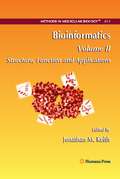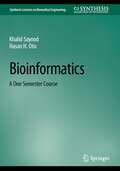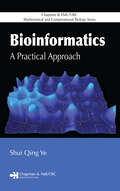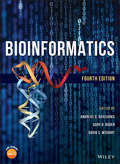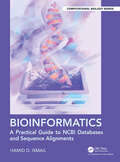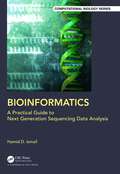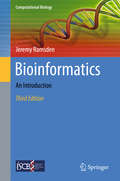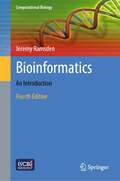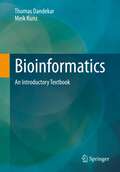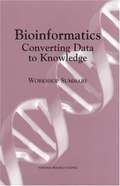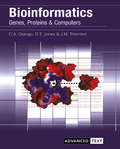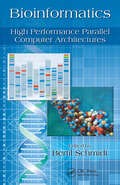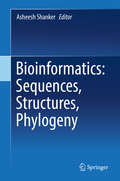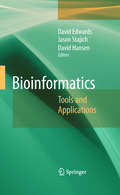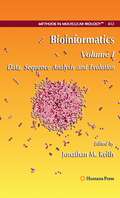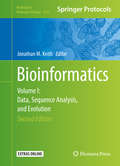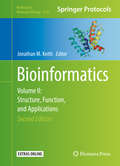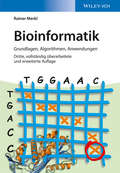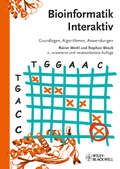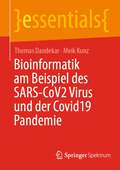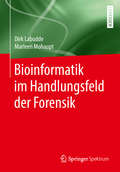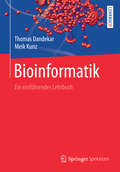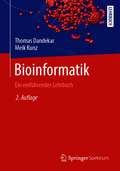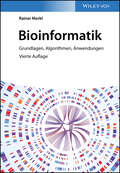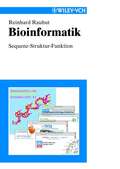- Table View
- List View
Bioinformatics, Volume II: Volume II: Structure, Function and Applications (Methods in Molecular Biology #453)
by Jonathan M. KeithNot only is the quantity of life science data expanding, but new types of biological data continue to be introduced as a result of technological development and a growing understanding of biological systems. Methods for analyzing these data are an increasingly important component of modern biological research. In Bioinformatics, leading researchers in the field provide a selection of the most useful and widely applicable methods, able to be applied as is, or with minor variations, to many specific problems. Volume II: Structure, Function and Applications contains methods pertinent to the prediction of protein and RNA structures and the analysis and classification of structures, methods for inferring the function of previously identified genomic elements, chiefly protein-coding genes, medical applications in diagnostics and drug discovery, and "meta-methods" for developers of bioinformatics algorithms. As a volume of the highly successful Methods in Molecular Biology™ series, this work provides the kind of detailed description and implementation advice that is crucial for getting optimal results.<P><P> Comprehensive and cutting-edge, Bioinformatics: Volume II: Structure, Function and Applications is an ideal reference for all scientists involved with the ever-growing array of data in the expanding field of life science.
Bioinformatics: A One Semester Course (Synthesis Lectures on Biomedical Engineering)
by Khalid Sayood Hasan H. OtuThis book focuses on bioinformatics, the study of the management and analysis of information used in biological systems. Particular emphasis explains to the reader how to study and extract useful information, such as relatedness of species, function of specific sequences, and genome organization from genomic sequences. This book focuses on the algorithmic aspects of bioinformatics and not on databases and software packages. There are two important discriminating characteristics that sets the book apart. It connects the algorithmic aspects and approaches to bioinformatics with the biological context while maintaining a user friendly and accessible description of the algorithms. The authors have curated the content for use a stand alone reference or the book will fit a one semester course on the subject.
Bioinformatics: A Practical Approach
by Shui Qing YeAn emerging, ever-evolving branch of science, bioinformatics has paved the way for the explosive growth in the distribution of biological information to a variety of biological databases, including the National Center for Biotechnology Information. For growth to continue in this field, biologists must obtain basic computer skills while computer spe
Bioinformatics: A Practical Guide To The Analysis Of Genes And Proteins (Methods Of Biochemical Analysis Ser. #145)
by Andreas D. Baxevanis Gary D. Bader David S. WishartPraise for the third edition of Bioinformatics “This book is a gem to read and use in practice.” —Briefings in Bioinformatics "This volume has a distinctive, special value as it offers an unrivalled level of details and unique expert insights from the leading computational biologists, including the very creators of popular bioinformatics tools." —ChemBioChem “A valuable survey of this fascinating field. . . I found it to be the most useful book on bioinformatics that I have seen and recommend it very highly.” —American Society for Microbiology News “This should be on the bookshelf of every molecular biologist.” —The Quarterly Review of Biology The field of bioinformatics is advancing at a remarkable rate. With the development of new analytical techniques that make use of the latest advances in machine learning and data science, today’s biologists are gaining fantastic new insights into the natural world’s most complex systems. These rapidly progressing innovations can, however, be difficult to keep pace with. The expanded fourth edition of the best-selling Bioinformatics aims to remedy this by providing students and professionals alike with a comprehensive survey of the current field. Revised to reflect recent advances in computational biology, it offers practical instruction on the gathering, analysis, and interpretation of data, as well as explanations of the most powerful algorithms presently used for biological discovery. Bioinformatics, Fourth Edition offers the most readable, up-to-date, and thorough introduction to the field for biologists at all levels, covering both key concepts that have stood the test of time and the new and important developments driving this fast-moving discipline forwards. This new edition features: New chapters on metabolomics, population genetics, metagenomics and microbial community analysis, and translational bioinformatics A thorough treatment of statistical methods as applied to biological data Special topic boxes and appendices highlighting experimental strategies and advanced concepts Annotated reference lists, comprehensive lists of relevant web resources, and an extensive glossary of commonly used terms in bioinformatics, genomics, and proteomics Bioinformatics is an indispensable companion for researchers, instructors, and students of all levels in molecular biology and computational biology, as well as investigators involved in genomics, clinical research, proteomics, and related fields.
Bioinformatics: A Practical Guide to NCBI Databases and Sequence Alignments (Chapman & Hall/CRC Computational Biology Series)
by Hamid D. IsmailBioinformatics: A Practical Guide to NCBI Databases and Sequence Alignments provides the basics of bioinformatics and in-depth coverage of NCBI databases, sequence alignment, and NCBI Sequence Local Alignment Search Tool (BLAST). As bioinformatics has become essential for life sciences, the book has been written specifically to address the need of a large audience including undergraduates, graduates, researchers, healthcare professionals, and bioinformatics professors who need to use the NCBI databases, retrieve data from them, and use BLAST to find evolutionarily related sequences, sequence annotation, construction of phylogenetic tree, and the conservative domain of a protein, to name just a few. Technical details of alignment algorithms are explained with a minimum use of mathematical formulas and with graphical illustrations. Key Features Provides readers with the most-used bioinformatics knowledge of bioinformatics databases and alignments including both theory and application via illustrations and worked examples. Discusses the use of Windows Command Prompt, Linux shell, R, and Python for both Entrez databases and BLAST. The companion website contains tutorials, R and Python codes, instructor materials including slides, exercises, and problems for students. This is the ideal textbook for bioinformatics courses taken by students of life sciences and for researchers wishing to develop their knowledge of bioinformatics to facilitate their own research.
Bioinformatics: A Practical Guide to Next Generation Sequencing Data Analysis (Chapman & Hall/CRC Computational Biology Series)
by Hamid D. IsmailThis book contains the latest material in the subject, covering next generation sequencing (NGS) applications and meeting the requirements of a complete semester course. This book digs deep into analysis, providing both concept and practice to satisfy the exact need of researchers seeking to understand and use NGS data reprocessing, genome assembly, variant discovery, gene profiling, epigenetics, and metagenomics. The book does not introduce the analysis pipelines in a black box, but with detailed analysis steps to provide readers with the scientific and technical backgrounds required to enable them to conduct analysis with confidence and understanding. The book is primarily designed as a companion for researchers and graduate students using sequencing data analysis but will also serve as a textbook for teachers and students in biology and bioscience.
Bioinformatics: An Introduction (Computational Biology #21)
by Jeremy RamsdenThis comprehensive textbook presents a self-contained guide to bioinformatics, defined in its broadest sense as the application of information science to biology. Thoroughly updated and greatly expanded, this third edition now includes material on the growing array of "-omics"; covering metagenomics, toxicogenomics, glycomics, lipidomics, microbiomics and phenomics. New chapters have also been added on ecosystems management and the nervous system. Emphasis is placed on providing both a firm grounding in the core concepts and a clear overview of the complete field of bioinformatics. Features: explains the fundamentals of information science relevant to biology; covers both organismal (ontogeny and phylogeny, as well as genome structure) and molecular aspects; examines the most important practical applications of bioinformatics, providing detailed descriptions of both the experimental process and the data analysis; provides a varied selection of problems throughout the book, to stimulate further thinking.
Bioinformatics: An Introduction (Computational Biology)
by Jeremy RamsdenThis invaluable textbook presents a self-contained introduction to the field of bioinformatics. Providing a comprehensive breadth of coverage while remaining accessibly concise, the text promotes a deep understanding of the field, supported by basic mathematical concepts, an emphasis on biological knowledge, and a holistic approach that highlights the connections unifying bioinformatics with other areas of science.The thoroughly revised and enhanced fourth edition features new chapters focusing on regulation and control networks, the origins of life, evolution, statistics and causation, viruses, the microbiome, single cell analysis, drug discovery and forensic applications. This edition additionally includes new and updated material on the ontology of bioinformatics, data mining, ecosystems, and phenomics. Also covered are new developments in sequencing technologies, gene editing methods, and modelling of the brain, as well as state-of-the-art medical applications. Of special topicality is a new chapter on bioinformatics aspects of the coronavirus pandemic.Topics and features:Explains the fundamentals of set theory, combinatorics, probability, likelihood, causality, clustering, pattern recognition, randomness, complexity, systems, and networksDiscusses topics on ontogeny, phylogeny, genome structure, and regulation, as well as aspects of molecular biologyCritically examines the most significant practical applications, offering detailed descriptions of both the experimental process and the analysis of the dataProvides a varied selection of problems throughout the book, to stimulate further thinkingEncourages further reading through the inclusion of an extensive bibliographyThis classic textbook builds upon the successful formula of previous editions with coverage of the latest advances in this exciting and fast-moving field. With its interdisciplinary scope, this unique guide will prove to be an essential study companion to a broad audience of undergraduate and beginning graduate students, spanning computer scientists focusing on bioinformatics, students of the physical sciences seeking a helpful primer on biology, and biologists desiring to better understand the theory underlying important applications of information science in biology.Dr. Jeremy Ramsden is Hon. Prof. of Nanotechnology in the Department of Biomedical Research at the University of Buckingham, UK.
Bioinformatics: An Introductory Textbook
by Thomas Dandekar Meik KunzThis book offers a gripping introduction to the fastest growing field of biology with easy-to-follow examples and a well-prepared appendix for the reader to cook up and experience everything right away.The book gets the reader started with the basics, such as how to easily find sequence information and then analyze it. In further chapters, the authors go into the various analysis options from RNA, DNA and proteins to entire metabolic pathways. Exciting examples from biology are chosen in each chapter to illustrate the analysis. Each chapter concludes with an exercise section that immediately puts what has been learned to use.The subject of this book is a must for any biology student, whether undergraduate or graduate, as bioinformatics is now unearthing amazing insights into the molecular basis of all living things. Computer science students and other students from related sciences will get a good introduction to bioinformatics, as biology and current topics (e.g. AI) are systematically introduced step by step alongside the software.Discover the key to life together with the authors and learn to understand the language of life. This book is a translation of the original German 2nd edition Bioinformatik by Thomas Dandekar and Meik Kunz, published by Springer-Verlag GmbH Germany, part of Springer Nature in 2021. The translation was done with the help of artificial intelligence (machine translation by the service DeepL.com). A subsequent human revision was done primarily in terms of content, so that the book will read stylistically differently from a conventional translation. Springer Nature works continuously to further the development of tools for the production of books and on the related technologies to support the authors.
Bioinformatics: Genes, Proteins and Computers (Advanced Texts)
by Christine Orengo, David Jones and Janet ThorntonBioinformatics, the use of computers to address biological questions, has become an essential tool in biological research. It is one of the critical keys needed to unlock the information encoded in the flood of data generated by genome, protein structure, transcriptome and proteome research.Bioinformatics: Genes, Proteins & Computers covers both the more traditional approaches to bioinformatics, including gene and protein sequence analysis and structure prediction, and more recent technologies such as datamining of transcriptomic and proteomic data to provide insights on cellular mechanisms and the causes of disease.
Bioinformatics: High Performance Parallel Computer Architectures (Embedded Multi-Core Systems)
by Bertil SchmidtNew sequencing technologies have broken many experimental barriers to genome scale sequencing, leading to the extraction of huge quantities of sequence data. This expansion of biological databases established the need for new ways to harness and apply the astounding amount of available genomic information and convert it into substantive biological
Bioinformatics: Sequences, Structures, Phylogeny
by Asheesh ShankerThis book provides a comprehensive overview of the concepts and approaches used for sequence, structure, and phylogenetic analysis. Starting with an introduction to the subject and intellectual property protection for bioinformatics, it guides readers through the latest sequencing technologies, sequence analysis, genomic variations, metagenomics, epigenomics, molecular evolution and phylogenetics, structural bioinformatics, protein folding, structure analysis and validation, drug discovery, reverse vaccinology, machine learning, application of R programming in biological data analysis, and the use of Linux in handling large data files.
Bioinformatics: Tools and Applications (Methods in Molecular Biology #Vol. 406)
by David Edwards Jason Stajich David HansenBioinformatics is a relatively new field of research. It evolved from the requirement to process, characterize, and apply the information being produced by DNA sequencing technology. The production of DNA sequence data continues to grow exponentially. At the same time, improved bioinformatics such as faster DNA sequence search methods have been combined with increasingly powerful computer systems to process this information. Methods are being developed for the ever more detailed quantification of gene expression, providing an insight into the function of the newly discovered genes, while molecular genetic tools provide a link between these genes and heritable traits. Genetic tests are now available to determine the likelihood of suffering specific ailments and can predict how plant cultivars may respond to the environment. The steps in the translation of the genetic blueprint to the observed phenotype is being increasingly understood through proteome, metabolome and phenome analysis, all underpinned by advances in bioinformatics. Bioinformatics is becoming increasingly central to the study of biology, and a day at a computer can often save a year or more in the laboratory. The volume is intended for graduate-level biology students as well as researchers who wish to gain a better understanding of applied bioinformatics and who wish to use bioinformatics technologies to assist in their research. The volume would also be of value to bioinformatics developers, particularly those from a computing background, who would like to understand the application of computational tools for biological research. Each chapter would include a comprehensive introduction giving an overview of the fundamentals, aimed at introducing graduate students and researchers from diverse backgrounds to the field and bring them up-to-date on the current state of knowledge. To accommodate the broad range of topics in applied bioinformatics, chapters have been grouped into themes: gene and genome analysis, molecular genetic analysis, gene expression analysis, protein and proteome analysis, metabolome analysis, phenome data analysis, literature mining and bioinformatics tool development. Each chapter and theme provides an introduction to the biology behind the data describes the requirements for data processing and details some of the methods applied to the data to enhance biological understanding.
Bioinformatics: Volume I: Data, Sequence Analysis and Evolution (Methods in Molecular Biology #452)
by Jonathan M. KeithIn this book, leading researchers in the field of Bioinformatics provide a selection of the most useful and widely applicable methods, able to be applied as is, or with minor variations, to many specific problems. Over 80 authors from around the globe contribute to the two volumes, including many leading experts in their respective subjects. They encompass topics from across the diverse field of bioinformatics through its broad scope, combining to provide an inter-disciplinary collaboration involving biologists, biochemists, physicists, mathematicians, statisticians and computer scientists.
Bioinformatics: Volume I: Data, Sequence Analysis, and Evolution (Methods in Molecular Biology #1525)
by Jonathan M. KeithIn Bioinformatics, leading researchers provide a selection of the most useful and widely applicable methods, able to be applied as is, or with minor variations, to many specific problems. Volume II: Structure, Function and Applications contains methods pertinent to the prediction of protein and RNA structures and the analysis and classification of structures, methods for inferring the function of previously identified genomic elements, chiefly protein-coding genes, medical applications in diagnostics and drug discovery, and "meta-methods" for developers of bioinformatics algorithms. Over 80 authors from around the globe have contributed to the two volumes.
Bioinformatics: Volume II: Structure, Function, and Applications (Methods in Molecular Biology #1526)
by Jonathan M. KeithIn Bioinformatics, leading researchers provide a selection of the most useful and widely applicable methods, able to be applied as is, or with minor variations, to many specific problems. Volume II: Structure, Function and Applications contains methods pertinent to the prediction of protein and RNA structures and the analysis and classification of structures, methods for inferring the function of previously identified genomic elements, chiefly protein-coding genes, medical applications in diagnostics and drug discovery, and "meta-methods" for developers of bioinformatics algorithms. Over 80 authors from around the globe have contributed to the two volumes.
Bioinformatik
by Rainer MerklDie zweite Auflage dieses erfolgreichen Lehrbuchs ist vollständig überarbeitet und in großen Teilen erweitert. Insbesondere wurde die Behandlung der Genomdatenanalyse deutlich vertieft und es wurden Kapitel über maschinelles Lernen, bayessche Netzwerke sowie Protein- und Enzymdesigns und über die Auswertung von Microarrays eingeführt. Außerdem steht dem Leser jetzt eine attraktive Webseite mit Zusatzmaterial und Fragen zum Stoff zur Verfügung. Webseite mit Zusatzmaterial und Fragen: WWW. WILEY-VCH. DE/HOME/BIOINFORMATIK
Bioinformatik Interaktiv
by Stephan Waack Rainer MerklDie zweite Auflage dieses erfolgreichen Lehrbuchs ist vollständig überarbeitet und in großen Teilen erweitert. Insbesondere wurde die Behandlung der Genomdatenanalyse deutlich vertieft und es wurden Kapitel über maschinelles Lernen, bayessche Netzwerke sowie Protein- und Enzymdesigns und über die Auswertung von Microarrays eingeführt. Außerdem steht dem Leser jetzt eine attraktive Webseite mit Zusatzmaterial und Fragen zum Stoff zur Verfügung. Webseite mit Zusatzmaterial und Fragen: WWW.WILEY-VCH.DE/HOME/BIOINFORMATIK
Bioinformatik am Beispiel des SARS-CoV2 Virus und der Covid19 Pandemie (essentials)
by Thomas Dandekar Meik KunzIn diesem Buch werden dem Leser einführend zentrale Ansätze der Bioinformatik entsprechend dem Fluss der genetischen Information von der Sequenzanalyse vom Virusgenom und seinen Proteinen über die Strukturvorhersage hin zu komplexeren Analysen (Interaktionen mit dem Wirt, Immunsystem) vorgestellt. Proteinnetzwerke, Metabolismus und Signalkaskaden erlauben dem Virus, eine hochgefährliche Infektion im Menschen zu erzeugen. Die Bioinformatik leistet wertvolle Hilfestellung bei der Diagnose, der Suche nach Behandlungsmöglichkeiten und vor allem bei der Herstellung von Impfstoffen und dem Vorhersehen des Pandemieverlaufs.Der InhaltBioinformatik ist einfach und schnell anzuwendenErste Detailanalysen (Sequenzen, Proteine, Gene)Analyse von Protein-NetzwerkenBioinformatik in der Infektionsbiologie und medizinische ImplikationenBioinformatik und Covid19 – ein globales PhänomenAnhang: Nützliche Webressourcen und LiteraturstellenDie ZielgruppenStudenten der Biologie und Medizin, die einen ersten Einblick in die Bioinformatik haben möchtenAllgemeines Publikum
Bioinformatik im Handlungsfeld der Forensik
by Dirk Labudde Marleen MohauptDieses Lehrbuch soll Studierenden den Einstieg in die Gebiete der Forensik und Bioinformatik gleichermaßen erleichtern. Anhand eines fiktiven Falls, der sich durch das gesamte Buch zieht, wird die Bioinformatik und deren Grundlagen in das Gebiet der Forensik übertragen. Der Fall deckt eine Vielzahl an biologischen Spuren, sowie deren klassische Analyse ab und definiert neue Handlungsfelder in der Bioinformatik und Forensik.In diesem Werk werden verschiedenste Bereiche der Forensik bioinformatisch aufbereitet: Genetischer Fingerabdruck: Auswertung auf Sequenz- statt auf Profilebene Fingerspuren: krankheitsbedingte bzw. genetisch bedingte VeränderungenUntersuchungen zum Phänotyp einer PersonGrundlegende Erkenntnisse zur Wundheilung sowie zur Blutalterung in- und ex-vivo Dieses Buch zeigt die Notwendigkeit auf, die Forensik um weitere Wissensbereiche zu ergänzen und gibt Einblicke in eine Vielzahl moderner Themen der Forensik wie zum Beispiel Populationsgenetik; Wundaltersbestimmung, Daktyloskopie oder Menschen ohne Fingerabdruck.Vor allem Studierende aus den Lebenswissenschaften sowie Dozierende ebendieser Fachrichtung, werden durch dieses Lehrbuch spannende Einblicke in topaktuelle Fragestellungen bekommen.
Bioinformatik: Ein einführendes Lehrbuch
by Thomas Dandekar Meik KunzDieses Buch bietet eine packende Einf#65533;hrung in das am schnellsten wachsende Gebiet der Biologie mit leicht nachvollziehbaren Beispielen und einem gut aufbereitetem Anhang f#65533;r den Leser, der so gleich alles direkt nachkochen und miterleben kann. Das Buch holt den Leser bei den Grundlagen ab, wie man zum Beispiel Sequenzinformationen einfach erh#65533;lt und analysiert. In weiteren Kapiteln gehen die Autoren auf die verschiedenen Analysem#65533;glichkeiten von RNA, DNA und Proteinen bis hinzu ganzen Stoffwechselwegen ein. Dabei werden in jedem Kapitel spannende Beispiele aus der Biologie gew#65533;hlt, die zur Veranschaulichung der Analyse dienen. Jedes Kapitel wird mit einem #65533;bungsteil abgeschlossen, welches das Gelernte sogleich zur Anwendung bringt. Das Thema dieses Buches ist ein Muss f#65533;r jeden Biologiestudierenden, ob Bachelor- oder Masterstudium, da die Bioinformatik mittlerweile erstaunliche Einsichten in die molekularen Grundlagen aller Lebewesen zutage f#65533;rdert.
Bioinformatik: Ein einführendes Lehrbuch
by Thomas Dandekar Meik KunzDieses Buch bietet eine packende Einführung in das am schnellsten wachsende Gebiet der Biologie mit leicht nachvollziehbaren Beispielen und einem gut aufbereiteten Anhang für die Leserschaft, um so gleich alles direkt nachkochen und miterleben zu können.Das Buch holt den Leser und die Leserin bei den Grundlagen ab, wie man zum Beispiel Sequenzinformationen einfach findet und dann analysiert. In weiteren Kapiteln gehen die Autoren auf die verschiedenen Analysemöglichkeiten von RNA, DNA und Proteinen bis hin zu ganzen Stoffwechselwegen ein. Dabei werden in jedem Kapitel spannende Beispiele aus der Biologie gewählt, die zur Veranschaulichung der Analyse dienen. Jedes Kapitel wird mit einem Übungsteil abgeschlossen, welches das Gelernte sogleich zur Anwendung bringt.Das Thema dieses Buches ist ein Muss für jeden Biologiestudierenden, ob Bachelor- oder Masterstudium, da die Bioinformatik mittlerweile erstaunliche Einsichten in die molekularen Grundlagen aller Lebewesen zutage fördert. Informatikstudierende und andere Studierende aus angrenzenden Naturwissenschaften bekommen einen guten Einstieg in die Bioinformatik, denn neben der Software werden systematisch die Biologie und aktuelle Themen (z.B. KI) Schritt für Schritt eingeführt.Entdecken Sie gemeinsam mit den Autoren den Schlüssel zum Leben und lernen Sie die Sprache des Lebens verstehen.
Bioinformatik: Grundlagen, Algorithmen, Anwendungen
by Rainer MerklBioinformatik Der Marktführer bei den Bioinformatiklehrbüchern in neuer Auflage und mit dem neuen Thema Molekulardynamik Bioinformatik ist eine Kerndisziplin in den modernen Biowssenschaften, von der Biotechnologie über die Biochemie und Molekularbiologie bis zur Molekulargenetik und Molekularmedizin. Sie ist eine essenzielle Grundlage für alle “omics”-Technologien, für die Strukturbiologie, die Systembiologie sowie die synthetische Biologie. Bioinformatik. Grundlagen, Algorithmen, Anwendungen bietet eine umfassende Einführung in die wichtigsten Methoden der Bioinformatik. Der Autor erklärt dabei sowohl die mathematischen und biologischen Grundlagen als auch die wichtigsten Software-Tools und deren Anwendungsbereiche. Schwerpunkte sind Methoden zum Sequenzvergleich, Verfahren zur Charakterisierung von Proteinfamilien, Algorithmen zur Vorhersage von Protein- und RNA-Strukturen, Methoden des maschinellen Lernens und das Proteindesign. Für die 4. Auflage wurde der Text durchgehend aktualisiert und um ein Kapitel zur Molekulardynamik erweitert. Neu aufgenommene Exkurse zu Meilensteinen der Bioinformatik und aktuellen Anwendungsgebieten lockern den Text auf. Auf der ebenfalls komplett überarbeiteten Begleit-Webseite werden interaktive Lernmodule bereitgestellt, einschließlich mehr als 120 Übungsaufgaben, zum Teil mit Lösungen. Eine perfekte Einführung für alle Studenten der Lebenswissenschaften oder Informatik, die einen Einblick in die gängigen Methoden der Bioinformatik benötigen, sowie ein wertvoller Begleiter für alle, die bereits bioinformatische Werkzeuge nutzen und die zugrundeliegenden Konzepte verstehen möchten.
Bioinformatik: Sequenz - Struktur - Funktion
by Reinhard RauhutDie Bioinformatik ist für die Weiterentwicklung der modernen Biowissenschaften von herausragender Bedeutung. In Grundzügen wird sie Teil einer jeden Ausbildung zum Biologen oder Biochemiker werden. Obwohl die Zahl der angebotenen Lehrveranstaltungen rapide zunimmt, gibt es bisher auf dem deutschsprachigen Markt noch kein Lehrbuch zu dieser Thematik. Das vorliegende Werk schließt diese Lücke. Reich bebildert und mit relativ wenig mathematischem Formelaufwand werden die Grundlagen der Bioinformatik gut verständlich aufbereitet. Die Themenauswahl ist dabei auf die Bedürfnisse der experimentell tätigen Biochemiker, Biologen und Mediziner abgestimmt. Auf die wichtigsten Hilfsmittel, die das Internet kostenlos bietet, wird ausführlich eingegangen. Die Inhalte werden in der Abfolge Sequenz - Struktur - Funktion entwickelt: · Sequenzdatenbanken · Genomprojekte · Proteinorientierte Datenbanken · Techniken des eukaryontischen Genomassembly · Strukturdatenbanken · Expressionsanalyse mit DNA Chips · Proteomics · Phylogenie und Sequenz · DNA Computing Die Bioinformatik betrifft die tägliche Arbeit eines jeden Biowissenschaftlers. Es sollte sich daher jeder mit den grundlegenden Ansätzen vertraut machen.
